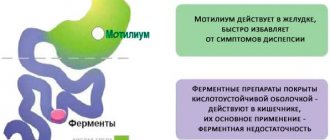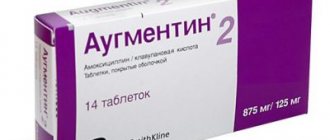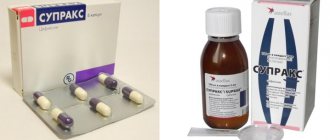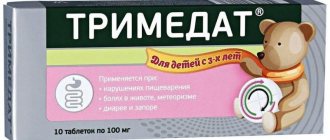Diseases of bacterial origin require timely treatment with the use of antibiotics, which are systemic drugs that allow them to act on the cause of the disease.
Flemoxin Solutab tablets from the group of penicillins, which have a pronounced antimicrobial effect and are well tolerated, are widely used among drugs.
An antibiotic in the middle price segment, so many are looking for analogues cheaper than Flemoxin, which will have the same composition or have a similar therapeutic effect.
There are plenty of drugs that can compete with the original, but before considering them, it is important to familiarize yourself with the properties and indications for taking Flemoxin Solutab.
Composition and release form
| Soluble tablets | 1 table |
| amoxicillin (as amoxicillin trihydrate) | 125 mg |
| 250 mg | |
| 500 mg | |
| 1000 mg | |
| excipients: dispersible cellulose; MCC; crospovidone; vanillin; tangerine flavor; lemon flavoring; saccharin; magnesium stearate |
5 pcs in blister; there are 4 blisters in a box (125, 250, 500, 1000 mg) or 7 pcs in a blister; There are 2 blisters in a box (125 mg).
Which is better - Flemoxin or Augmentin
When prescribing an antibiotic, doctors often opt for Augmentin, which is a good drug in the treatment of diseases of bacterial origin.
If we compare both drugs, it can be noted that both Augmentin and Flemoxin Solutab are antibiotics of the penicillin group.
A distinctive feature between these drugs is that the analog contains clavulanic acid in addition to amoxicillin trihydrate.
It prevents the main substance from being destroyed by certain types of bacteria, and this expands the range of uses of the medicine.
Augmentin - has a wider list of contraindications; it is not prescribed to pregnant women and nursing mothers, and is also prohibited in cases of hypersensitivity to penicillins.
Adults take oblong tablets, children take a suspension. The dose is prescribed by the attending physician.
If you consider both antibiotics, choosing which is better requires consultation with a specialist.
Pharmacodynamics
Active against such gram-positive and gram-negative microorganisms as Streptococcus pyogenes, Streptococcus pneumonia, Clostridium tetani, C.welchii, Neisseria gonorrhoeae, Neisseria meningitidis, Staphylococcus aureus (not producing beta-lactamase), Bacillus anthracis, Listeria monocytogenes, Helicobacter pylori. Less active against Enterococcus faecalis, Escherichia coli, Proteus mirabilis, Salmonella typhi, Shigella sonnei, Vibrio cholerae. Not active against microorganisms producing beta-lactamases, Pseudomonas spp., indole-positive Proteus spp., Serratia spp., Enterobacter spp.
Pharmacokinetics
Suction
After oral administration, it is absorbed quickly and almost completely (about 93%), acid-stable. After oral administration at a dose of 500 mg, the Cmax of the active substance in plasma is 5 mcg/ml and is observed in the blood plasma after 2 hours. When the dose of the drug is increased or decreased by 2 times, Cmax in the blood plasma also changes by 2 times. Food intake has virtually no effect on the absorption of the drug.
Distribution
Plasma protein binding is about 20%. Amoxicillin penetrates well into mucous membranes, bone tissue, intraocular fluid and sputum in therapeutically effective concentrations. The concentration of amoxicillin in bile exceeds its concentration in blood plasma by 2–4 times. In amniotic fluid and umbilical vessels, the concentration of amoxicillin is 25–30% of its level in the blood plasma of a pregnant woman.
It penetrates poorly through the BBB, but during inflammation of the meninges, the concentration in the cerebrospinal fluid is about 20% of the concentration in the blood plasma.
Metabolism
Partially metabolized, most of its metabolites are inactive against microorganisms.
Removal
It is eliminated primarily by the kidneys, about 80% by tubular excretion, 20% by glomerular filtration. In the absence of renal dysfunction, T1/2 is 1–1.5 hours. In premature infants, newborns and children under 6 months—3–4 hours.
Pharmacokinetics in special clinical cases.
T1/2 of amoxicillin does not change with impaired liver function.
If renal function is impaired (Cl creatinine ≤15 ml/min), T1/2 of amoxicillin may increase and reaches 8.5 hours in anuria.
Flemoxin or Flemoklav
You can replace Flemoxin Solutab with a structural analogue of Flemoklav, which is a combined antibiotic that contains not only ampicillin, but also clavulanic acid.
Both drugs are products of Astellas Pharma Inc. (Netherlands). They are used in the treatment of respiratory pathologies and ENT diseases, and can be used in pediatrics.
The principle of their action is identical, but there is a significant difference in the doses, so before taking the medicine it is important to study the instructions.
Side effects
From the gastrointestinal tract: rarely - changes in taste, nausea, vomiting, diarrhea; in some cases - a moderate increase in the activity of liver transaminases; extremely rarely - pseudomembranous and hemorrhagic colitis.
From the urinary system: extremely rarely - the development of interstitial nephritis.
From the hematopoietic system: agranulocytosis, neutropenia, thrombocytopenia, hemolytic anemia are possible, but they are also extremely rare.
Side effects from the nervous system when using amoxicillin in the dosage form of dispersible tablets have not been registered.
Allergic reactions: skin reactions, mainly in the form of a specific maculopapular rash; rarely - exudative erythema multiforme (Stevens-Johnson syndrome); in some cases - anaphylactic shock, angioedema.
Interaction
Probenecid, phenylbutazone, oxyphenbutazone, and to a lesser extent acetylsalicylic acid and sulfinpyrazone, inhibit the tubular secretion of penicillins, which leads to an increase in the half-life and an increase in the concentration of amoxicillin in the blood plasma. Bactericidal antibiotics (including aminoglycosides, cephalosporins, vancomycin, rifampicin) have a synergistic effect when taken simultaneously; antagonism is possible when taken with some bacteriostatic drugs (for example, chloramphenicol, sulfonamides). Concomitant use with estrogen-containing oral contraceptives may lead to a decrease in their effectiveness and an increased risk of breakthrough bleeding). Concomitant administration with allopurinol does not increase the frequency of skin reactions, unlike the combination of allopurinol with ampicillin.
Children's analogs of Flemoxin Solutaba
The range of antibiotics for children is quite large, but any medicine can only be prescribed by a pediatrician.
Flemoxin Solutab is not available in granules, so if necessary, the doctor can prescribe a structural analogue or a drug from a different group, but with an identical therapeutic effect.
Children from 6 years of age can take antibiotics in the form of tablets, and only from 12 years of age capsules are allowed for use.
Antibacterial drugs in the form of injection ampoules are suitable for children of all ages, but such drugs are administered only in a hospital.
In practice, the following drugs are most often used:
- Macropen – from 276 rub. Antibiotic from the macrolide group. Has a pronounced antibacterial effect. It is often used when a child is intolerant to drugs of the penicillin group. The active component of Macropen is clarithromycin.
- Klacid – from 371 rub. An antibiotic based on clarithromycin, a macrolide. For children it is available in a 200 ml bottle. Currently, the drug is considered one of the most effective and safe, often prescribed in pediatrics for the treatment of otitis media, bronchitis, pneumonia and other ENT diseases.
- Augmentin – from 480 rub. An analogue of Flemoxy Solutab, but in addition to amoxicillin it contains clavulanic acid, which enhances the effect of the antibiotic and helps cope with bacteria that are resistant to penicillin. Children are prescribed Augmentin suspension, which has good reviews and is often used in pediatrics.
- Cefuroxime – from 1250 rub. A drug from the cephalosporin group. Prescribed to children when the disease is advanced or penicillin antibiotics have not shown effectiveness. For children, only an injection solution can be used, which is administered in a hospital setting under the supervision of a physician.
- Amoxiclav – from 395 rub. An antibacterial drug from the penicillin group with a beta-lactamase inhibitor. For children it is provided in the form of a suspension for oral administration. In addition to amoxicillin trihydrate, the drug contains clavulanic acid. Available in a 200 ml bottle containing granules for preparing a suspension.
In addition to the above antibiotics used in pediatrics, there are others that are no less effective. However, the choice of drug always remains with the attending physician.
Directions for use and doses
Inside, before, during or after meals. The tablet can be swallowed whole, divided into pieces or chewed with a glass of water or diluted in water to form a syrup (20 ml) or suspension (100 ml).
Adults and children over 10 years of age (for mild to moderate infections) - 500–750 mg 2 times a day or 375–500 mg 3 times a day.
Children from 3 to 10 years old - 375 mg 2 times a day or 250 mg 3 times a day; from 1 year to 3 years - 250 mg 2 times a day or 125 mg 3 times a day. The daily dose for children (including children under 1 year of age) is 30–60 mg/kg/day, divided into 2–3 doses.
When treating severe infections, as well as for infections with hard-to-reach foci (for example, acute otitis media), a three-time dose of the drug is preferable.
For chronic diseases, relapses, severe infections: adults - 0.75–1 g 3 times a day, children - up to 60 mg/kg/day in 3 divided doses.
For acute uncomplicated gonorrhea - 3 g, once, in combination with 1 g probenecid.
For mild to moderate infections, treatment is carried out for 5-7 days, for infections caused by Streptococcus pyogenes - at least 10 days.
When treating chronic diseases and severe infections, the dose of the drug should be determined by the clinical picture of the disease. The drug is continued for 48 hours after the symptoms of the disease disappear.
For patients with creatinine Cl below 10 ml/min, the dose is reduced by 15–50%.
Suprax or Flemoxin Solutab - which is better?
Recently, the antibiotic Suprax, which belongs to another pharmacological group - third generation cephalosporins, has been increasingly used in practice. The difference between the drugs is significant and lies not only in different groups, but also in the mechanism of action.
Suprax contains cefixime trihydrate and auxiliary components.
If we consider both drugs, it can be noted that Suprax is a stronger antibiotic, so doctors prefer to prescribe it for serious conditions or when other drugs do not bring the expected result.
The disadvantage of the drug is the list of contraindications and side effects, which is much longer than that of Flemoxin.
The price of the antibiotic Suprax is higher, but the effect of treatment is noticeable already on the 2nd day of use. This article will help you find a budget-friendly and effective replacement.
special instructions
A history of erythroderma is not a contraindication for the use of Flemoxin Solutab®.
Cross-resistance with penicillin drugs and cephalosporins is possible.
As with other penicillin drugs, superinfection may develop.
The appearance of severe diarrhea, characteristic of pseudomembranous colitis, is an indication for discontinuation of the drug.
The drug should be prescribed to patients with infectious mononucleosis and lymphocytic leukemia with caution, because there is a high probability of the appearance of exanthema of non-allergic origin.
List of inexpensive structural analogues
Flemoxin Solutab has many similar substitutes made in Russia and abroad.
These analogues contain amoxicillin and are an exact copy of the original antibiotic.
Their cost differs, and the reason for this is both the country of origin and the degree of purification of the medicine during the manufacturing process.
Structural analogues identical to Flemoxin include the following drugs:
- Amoxil – from 185 rub. Antibiotic based on amoxicillin, domestically produced. It can be prescribed to children from 3 years of age, but in practice it is used extremely rarely due to its high toxicity to the body.
- Gonoform – from 80 rub. A cheap analogue of Flemoxin Solutab with a similar therapeutic effect. Available in the form of granules, powder and solution for injection.
- Ospamox – from 150 rub. A more gentle substitute for the original based on amoxicillin. Taking the medicine inhibits the growth and reproduction of bacteria, reducing the risk of complications. For children it is available in the form of a suspension. The average price for a medicine is 200 rubles.
- Amoxisar – from 180 rub. An antimicrobial drug of the penicillin group, often used in the treatment of diseases of infectious origin. Used for children and adults, but only as prescribed by a doctor. It is available on the pharmacological market in several forms - tablets, solution for intravenous or intramuscular administration.





